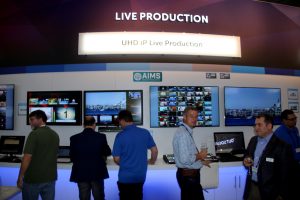Imagine CTO Steve Reynolds says three years of IP efforts are paying off
It’s pretty clear that when it comes to going all-in on IP Imagine Communications has done everything it can to take a leadership position. And while many vendors at IBC this year were finally getting serious about IP the Imagine stand showed the fruits of efforts that began years ago. “We really feel the approach we’ve taken, beginning three years ago when we started working on it from the ground up, now gives us a generation of products built to fulfill our vision of native cloud software platforms that can scale and be flexible,” says Steve Reynolds, Imagine Communications, CTO.

The Xenium platform is the backbone of the efforts, a component-based framework that allows for components to be built on top of it.
“It can be as simple as a closed captioning inserter or a delay buffer or be as complex as things like HEVC encoders,” he explains. “Micro-services can be put together to create a software-defined workflow.”
One of the interesting aspects of the move to IP is that while the concept may be more ubiquitous across the halls at trade shows (and, increasingly, within broadcast plants) how it is actually being used can vary widely.
“Everyone can say the same words but they don’t all mean the same thing,” says Reynolds. “For some it is about changing the wire but that is not the same things as moving to IP. It’s a wholesale change in the way you build, architect, support, and monitor a plant as you move from a hardware-based model to a software-based model. There is no more custom-made hardware as you are running software on commodity-off-the-shelf networking that takes advantages of all of the goodness of the Internet; the same protocols, development tools, Web-service APIs, and Javascript.”
This move to a new world where systems move beyond hardware has Imagine (and others) investing a lot in not only R&D but also training to help people and organizations understand how to make a hybrid migration.

“Many have large baseband infrastructures and the industry has never taken an approach that is ‘rip and replace’ so they are building overlays on top of existing infrastructures and gateways to take IP content.”
One question that many are still grappling with is how to monitor, troubleshoot, and verify an IP signal.
“Our approach offers a set of tools for IP that address those questions,” says Reynolds. “The Epic platform is seen by many as a software-defined multiviewer environment but it is so much more than that. It allows for management and monitoring of things like loudness levels and tools to watch the platform itself and see how the infrastructure and network is behaving. And there are tools to look at how the system performs over time that offers a higher level of quality control.”
The changes related to the move IP will impact more than just the engineering department. The move to IP opens up the move to virtualized computing environments where the processing power of the computer can be dynamically changed to meet a given of-the-moment need. The days, for example, of dedicated racks of equipment that may only be used for an hour or two a week looks like it will increasingly become a thing of the past. And that ripple effect will impact everything from equipment manufacturing, sales, support, and budgeting.
“This is going to cost some of the companies in the industry their business as they will note make the transition to IP,” says Reynolds. “But that speaks to other opportunities.”
Reynolds says the advantages of a virtualized environment include agility and the ability to move faster because everyone is making ups of open- and standards-based platforms.
“The ways of doing things have been pioneered by other industries and we’re taking advantage of stuff built by others and that is giving us the ability to tap into what others have perfected,” says Reynolds. “With off-the-shelf standardized platforms there is not a lot of mystery and they are stable platforms that we don’t have to invent.”

